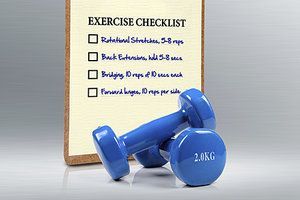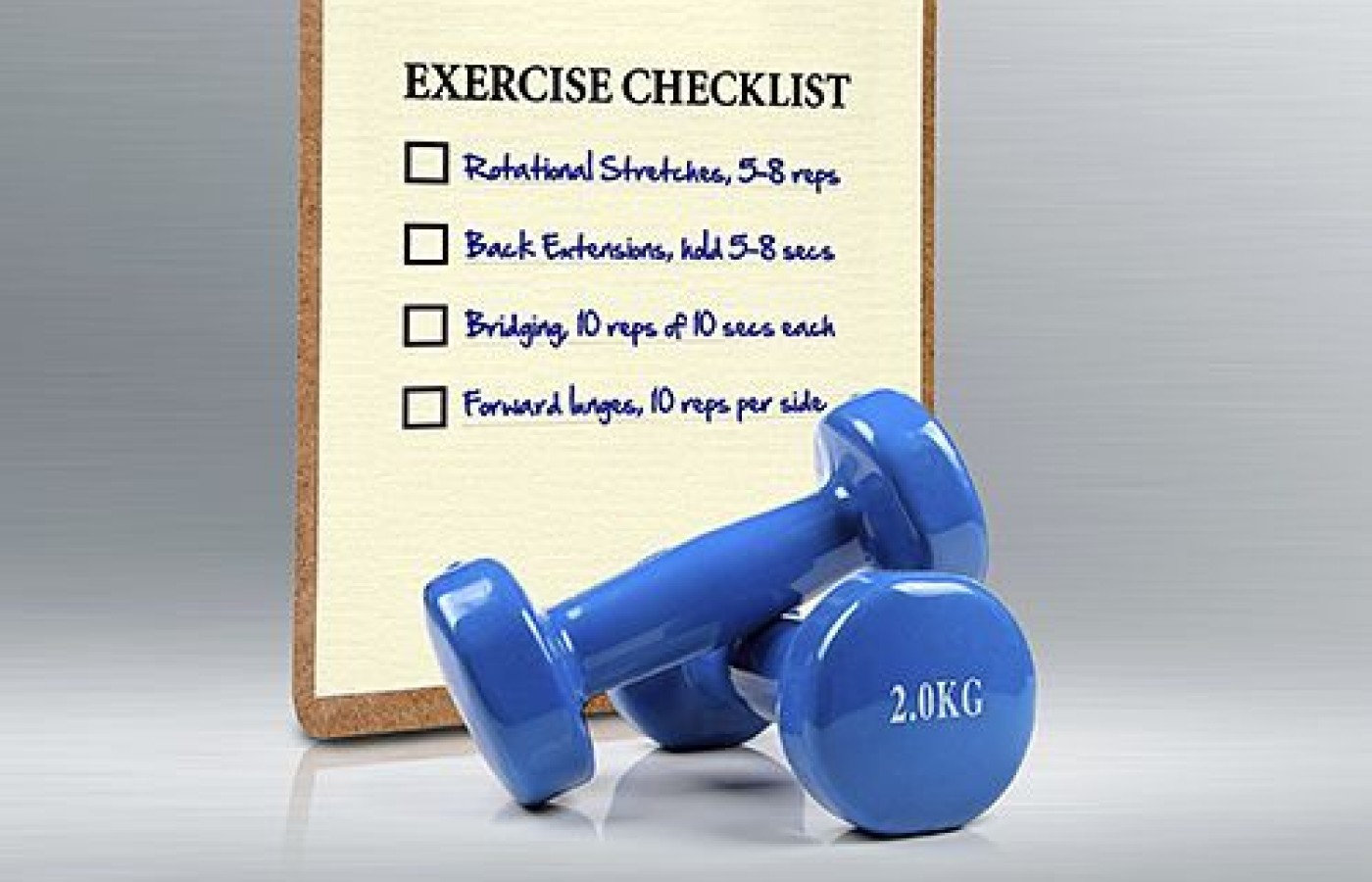Recent laws in New Jersey and California represent a disturbing trend that will negatively impact a practice’s ability to collect monies from patients, as well as expose them to significant penalties if the practice does not follow the mandatory guidelines to a T. Please be aware that a similar law may be coming to your state. The time to act is before the law is passed.
Overcoming Barriers to Exercise Compliance
One of the most common questions other practitioners ask me is, "How do I get patients to do their exercises?" I am not frustrated by my patient compliance, as many doctors are; in fact, I am actually happy with my patients' involvement and commitment. I sense this has to do with my commitment as part of a rehab practice to increase patients' activities of daily living, decrease pain with activities, and educate patients about quality aging.
Whether you use manual skills, modalities, stretching, strengthening, nutrition, weight loss, exercise therapy, sports taping, deep-tissue / fascial therapy, etc., patient compliance goes up when patients know they are being "watched" and retested. I do everything I can to discover and correct the issues obstructing the quality of my patients' lives, but I expect them to perform home exercises in conjunction with my in-office manipulation and treatments. The bottom line: Help patients get out of pain as fast as possible and then keep them that way! Here are some tips to motivate your patients to follow through with your home exercise recommendations.
Step 1: Establish Specific Goals

The first step to increase home exercise compliance is having patients make specific goals they want to achieve. I make a list of these goals and then give them my honest assessment of how long it will take to achieve each goal if they follow my recommendations.
I explain to patients, "I am going to help you understand how to resolve and prevent the muscle conflicts you have. You may need to strengthen or facilitate your stabilizer muscles; learn how to access your core (I explain what that means in simple terms); organize your fascia (I relate this to scar tissue and stiffness, and explain the importance of fascial therapy and muscle coordination). I emphasize the importance of movement therapy; how to inhibit muscles; dynamic mobility drills; how to overcome inefficient neuronal confusion; and so on.
In each instance, I give the patient the same message: I will provide in-office treatments (manipulation, therapies, etc.), and teach them a variety of movements and exercises that must be done at home on their own. I also tell them, "I expect you to do these exercises. Without creating goals or taking time to educate and teach you what to do at home, the work I do here in my office may not have long-term effects and benefits."
Step 2: Teach Body Awareness
Step two in getting patients to be compliant in doing home exercises is teaching them body awareness – communicating what I see during my evaluation from a place of compassion, calm, clarity and confidence. With the patient standing in front of a mirror, static postural evaluation begins. I pay close attention to the feet, knees, lumbo-pelvis-hips, spine, ribs, sternum, scapula and head. The standing posture "checkpoints" turns into an observation of the patient's breathing pattern; while in the same standing position, the temporomanbibular joint, cervical spine, shoulder, thoracic spine and lumbar spine ranges of motion can be evaluated and explored.
The patient is well-aware of the results of my evaluation because they are interacting with me and describing how these motions make them feel (restricted, tight, loose, sore, etc.).
The range-of-motion evaluation becomes an arms-overhead squat assessment, which provides information to me (and the patient) about the patient's foot and ankle mobility (especially ankle dorsiflexion and foot pronation). I look to see if the knees are moving inward or outward, and watch the lumbo-pelvic-hip complex move (or not move), the depth of the squat, and what the thoracic spine feels like (stiff, tight, limited, etc.).
Next, I educate the patient on what "normal" standing alignment looks like and they tell me about their foot arches, ankle alignment, tibial alignment and patella alignment. It often amazes me because patients act as if they are seeing their feet for the first time! During this process of evaluation, I am educating as we observe together, so they know how they compare to "neutral."
Then I ask the patient to perform small knee bends (about 30 degrees of knee flexion), because that amount of knee flexion mimics the knee motion of them going up and down stairs or running. If they have orthotics, they do the same small knee bends with their orthotics on and then tell me if the pair they are using is helping them or not. If they don't have an orthotic, this is an opportunity for me to try and see if one will enhance movement. They get to see and feel if an orthotic is going to help their alignment.
The small knee bends easily reveal what the knee is doing (e.g., moving inward or outward) and assists me in determining if the ankle or the hip has a dominate dysfunction.
Performing these types of tests along with goniometer-measured ranges of motion gives the patient awareness of their movement and alignment – or lack of movement and alignment. I allow them to see and feel their own body as it moves. Remote dysfunctional movement patterns become obvious to the patient; they tell me and see the issues, and "get" the connection to their pain. Within minutes of the evaluation, patients begin asking me, "What can I do to fix this?" You know my answer!
Don't miss the chance to observe static posture and the way a patient walks up and down your hallway. Teaching patients body awareness concepts also points to the importance of sensory-motor training, strength training, soft-tissue therapy and manipulation, all of which will enhance compliance.
Step 3: Outline a Program
As I perform additional chiropractic and orthopedic objective tests, treatment interventions unfold. I explain to the patient, "There are things I can only do in the office, such as laser therapy, deep muscle stimulation and other techniques, but all of your treatment sessions will be combined with home exercise. It's well-documented that patients who combine therapy and exercise achieve the best results."
I continue to explain to the patient that their individualized, customized treatment plan is a layered approach – my skilled hands for fascial therapy, adjusting, mobilization and manipulation; their commitment to performing daily exercises I teach them while we are together in the office.
These days, my routines are mostly facilitation training, flexibility training, mobility drills and strength routines with the patient's own body weight. I teach exercises utilizing bands, balls and kettlebells to those who need it. I also have patients fill out a "systems survey" questionnaire that gives me an opportunity to discuss diet recommendations, personalized nutrition needs, sleep hygiene and related topics.
Other Tips to Increase Compliance
Set Realistic Goals: Compliance is going to be better if you create reasonable goals with realistic time frames ("Your goal of improving your posture will take a year" or "Resolving your GERD and achieving your weight-loss goal will take 5-6 months"), and if you make sure patients know you are going to be following up and rechecking. I also recommend you help patients figure out what time of day to do the exercises, and give them a range of reps and sets.
Know Your Patient: I seem to be able to teach more exercises (meaning 2-3 exercises per session) to patients in the 30-plus age group. Patients who are more inclined to perform corrective exercise and are more compliant are generally older; in my practice, it's the younger patients who are more of a challenge.
Patients already involved with sports (no matter the age) comply better than those not involved in sports (Schneider, 1998; Rejesk, 1997). Sedentary people do not initially identify with exercise as a means to recovery. They need extra coaching about lifestyle changes. Some people exhibit fear avoidance when it comes to exercise because of their fragility and the fact that previous attempts at exercise have caused flare-ups of their health issues. They need more hand holding and smaller exercise gradients.
Take Time to Listen: Be a practitioner with a keen sense to see a person's true essence, often hidden underneath chronic pain and chronic complaints. Patients seem to comply better if you are responsive to their needs and demands. Take time to listen to the patient's attitudes about exercise. Be reasonable and alleviate fears relating to the painful dysfunction (Sluijs, 1998). Educate them on the benefits and function of the exercise (e.g., "This exercise routine will resolve / reduce pain in your TFL caused by running"). Listen to perceived barriers and reasons why they say they can't exercise at home (lack of space, no time, etc.).
Don't Overwhelm Them: Minimize the number of exercises prescribed per session. I may perform 6-12 exercises in the office, but I will only prescribe a few at a time for home therapy. The "at-home number" seems to be 2-3 or 3-4, depending on the patient (Henry, 1998). By the end of 4-5 sessions, a patient may have 8-15 different exercises to perform at home on their own. If they know regular progress checks are planned, they are more likely to do them.
Provide Written and Visual Information: Devices that provide biofeedback (ROM devices, stabilizer cuffs, real-time strength changes, etc.) seem to motivate patients.
Personalize It: The last suggestion is to provide treatment that's totally personalized by listening, connecting, suggesting, advising, and performing assessments / tests that will help dictate treatment. To me, experimental exercise offers ways to integrate disowned parts of the body and gets patients more involved in care.



